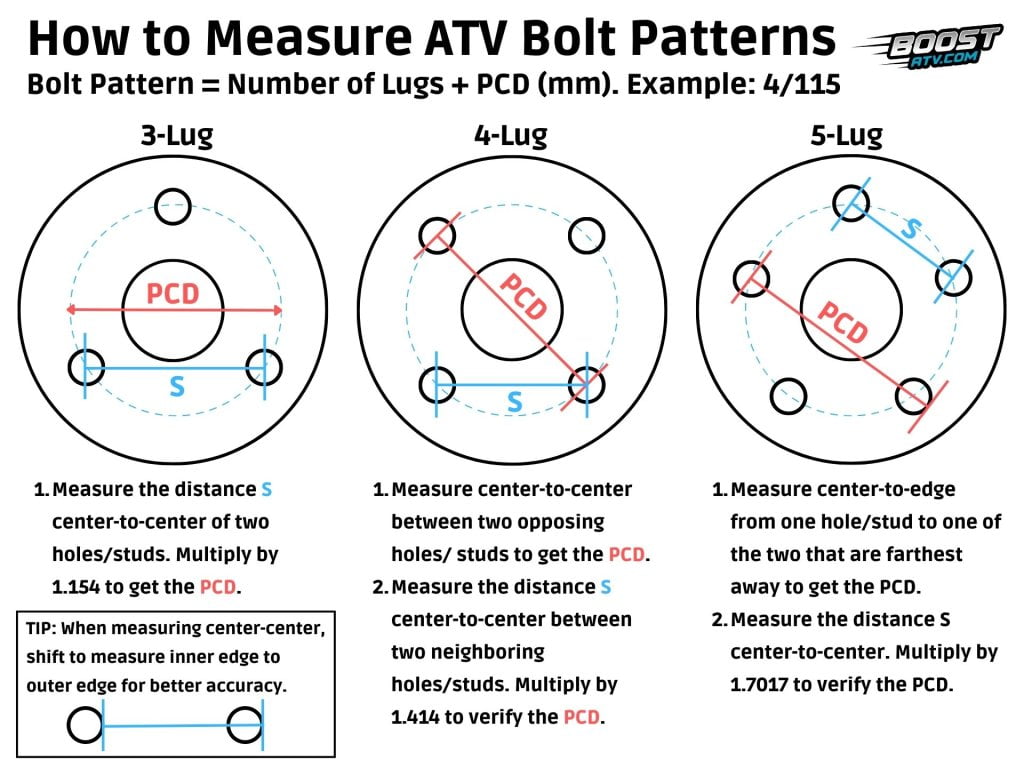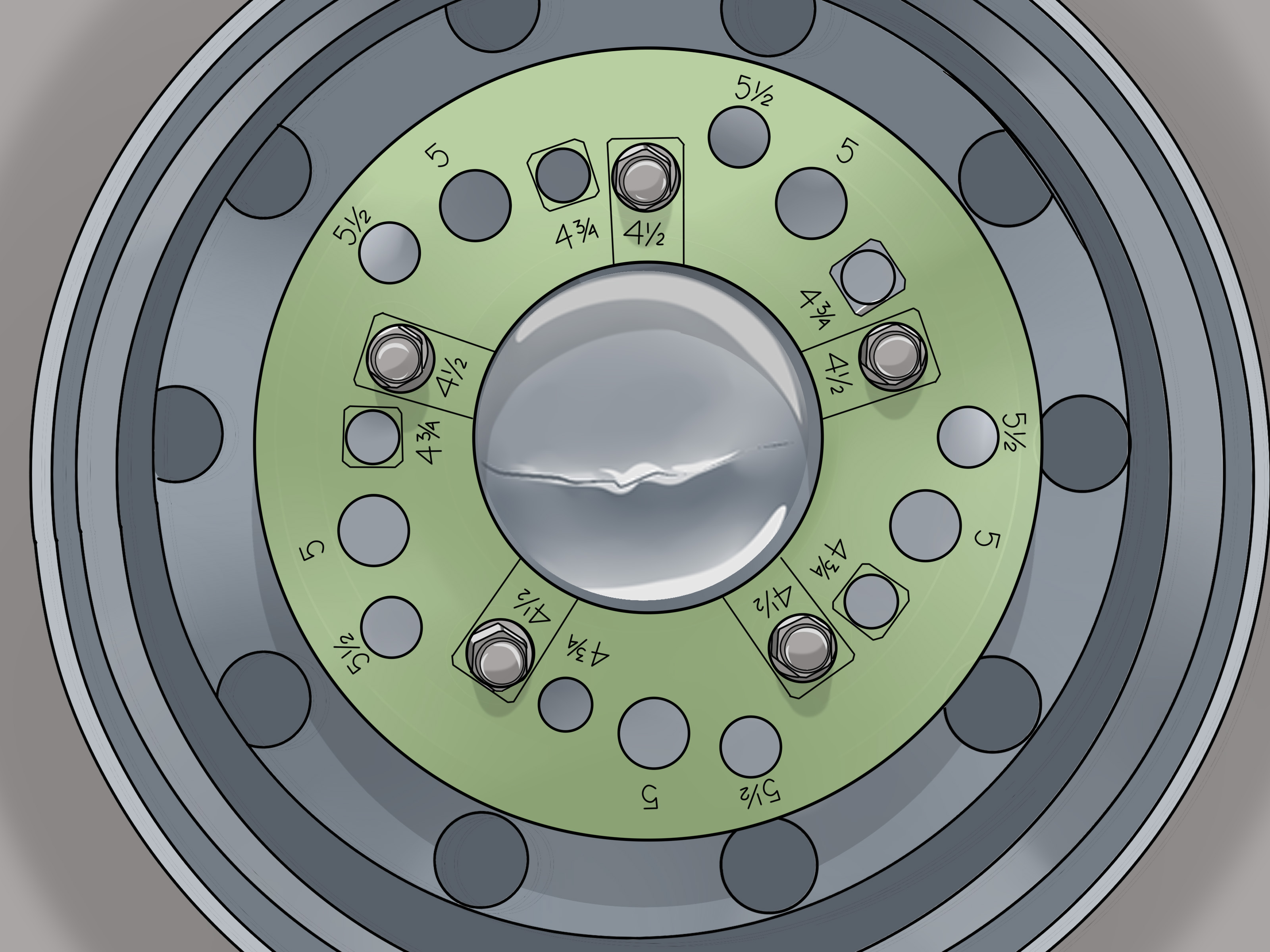Mastering Wheel Bolt Pattern Measurement: Your Ultimate Guide

Ever wondered how to ensure your new wheels fit perfectly? The key lies in understanding your vehicle's wheel lug bolt pattern. This seemingly small detail plays a crucial role in ensuring safe and efficient driving. Incorrectly fitted wheels can lead to vibrations, premature wear, and even dangerous detachment. This guide provides a comprehensive overview of determining your wheel bolt pattern.
Measuring a wheel bolt pattern, often referred to as a lug pattern, PCD (Pitch Circle Diameter), or bolt circle, is a fundamental skill for any car enthusiast. It defines the arrangement of the lug holes on the wheel hub, dictating which wheels are compatible with your vehicle. Imagine the frustration of purchasing new wheels only to discover they don't fit! This guide will empower you to confidently determine your bolt pattern and avoid such headaches.
The standardization of wheel bolt patterns arose from the necessity of interchangeable wheels, improving vehicle maintenance and repair. Early automobiles lacked this standardization, making wheel replacement a complex and time-consuming process. Over time, manufacturers adopted standard bolt patterns, simplifying wheel changes and promoting compatibility across different vehicle models.
Accurate bolt pattern measurement is crucial for safety and performance. An improperly fitted wheel can loosen during driving, leading to potential loss of control. Additionally, an incorrect bolt pattern can cause stress on the wheel studs, hubs, and suspension components, leading to premature wear and tear. Understanding how to measure your bolt pattern ensures both your safety and the longevity of your vehicle.
One of the primary issues encountered when measuring bolt patterns is confusion between different measurement systems. Some patterns are measured in millimeters (mm) while others are measured in inches. Furthermore, accurately measuring the diameter of the circle formed by the lug holes can be challenging without the right tools and techniques. This guide will clarify these potential obstacles and provide clear instructions for accurate measurement.
A wheel bolt pattern is typically expressed as two numbers: the number of lug holes and the diameter of the circle formed by those holes (PCD). For example, a 5x114.3 bolt pattern signifies 5 lug holes and a PCD of 114.3mm. Understanding this notation is crucial for correctly identifying compatible wheels.
Measuring a 4-lug or 6-lug pattern is relatively straightforward. For 4-lug patterns, measure the distance center-to-center between two opposing lug holes. For 6-lug patterns, measure the distance center-to-center between any two non-adjacent lug holes. For 5-lug patterns, the process is slightly more complex, requiring some basic geometry or a dedicated lug pattern measurement tool.
Benefit 1: Ensures Proper Wheel Fitment: Accurately measuring your bolt pattern guarantees that your chosen wheels will fit correctly, avoiding potential safety hazards and performance issues.
Benefit 2: Prevents Damage to Vehicle Components: Incorrect bolt patterns can stress wheel studs, hubs, and suspension components. Proper measurement prevents this damage, saving you costly repairs.
Benefit 3: Enables Informed Wheel Purchases: Knowing your bolt pattern empowers you to confidently shop for wheels, eliminating the risk of buying incompatible products.
Step-by-Step Guide for 5-Lug Wheels:
1. Measure from the center of one lug hole to the furthest outer edge of the opposite lug hole.
2. Multiply this measurement by 1.051. This will give you an approximate PCD.
3. Consult a bolt pattern chart to confirm the closest standard PCD.Advantages and Disadvantages of Measuring Yourself
| Advantages | Disadvantages |
|---|---|
| Saves money on professional measurement. | Potential for inaccuracy if not done carefully. |
| Convenient and can be done at home. | Requires basic tools and knowledge. |
Best Practice 1: Use a calibrated ruler or caliper for accurate measurements.
Best Practice 2: Double-check your measurements to avoid errors.
Best Practice 3: Consult a bolt pattern chart to confirm your findings.
Best Practice 4: Clean the wheel hub surface for accurate measurements.
Best Practice 5: For 5-lug patterns, consider using a dedicated lug pattern measurement tool.
FAQ 1: What is a wheel bolt pattern? It's the arrangement of lug holes on a wheel hub.
FAQ 2: Why is it important to know my bolt pattern? It ensures proper wheel fitment and prevents damage.
FAQ 3: How do I measure a 4-lug pattern? Measure center-to-center between two opposing lugs.
FAQ 4: How do I measure a 5-lug pattern? Use the diagonal method or a specific tool.
FAQ 5: How do I measure a 6-lug pattern? Measure center-to-center between non-adjacent lugs.
FAQ 6: Where can I find a bolt pattern chart? Online or at auto parts stores.
FAQ 7: What happens if I use the wrong bolt pattern? It can lead to dangerous wheel detachment.
FAQ 8: Can I measure the bolt pattern on the wheel itself? Yes, but measuring on the hub is often easier.
Tip: Use a piece of paper and a pencil to mark the lug hole centers for more precise measurements.
In conclusion, knowing how to determine a wheel lug bolt pattern is essential for every vehicle owner. Accurate measurement ensures proper wheel fitment, prevents damage to vehicle components, and promotes safe driving. By following the steps and tips outlined in this guide, you can confidently determine your vehicle's bolt pattern and avoid the pitfalls of incompatible wheels. Take the time to measure correctly, and enjoy the peace of mind that comes with knowing your wheels are securely and properly fitted. Investing a few minutes in this process can save you from significant headaches and potential safety risks down the road. Ensure your vehicle's safety and performance by mastering this essential skill. Don't hesitate to consult resources like online bolt pattern charts and seek professional assistance if needed.
The ultimate guide to the baggallini extra large carryall tote
Vacuum pump air compressor units a buyers guide
Finding peace exploring the lurman woodland therapeutic garden












